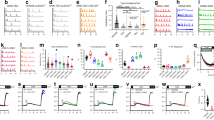Abstract
Replying to H. Vais, J. K. Foskett & D.-O. D. Mak Nature 478, doi:10.1038/nature10493 (2011)
We observe that under conditions designed to mimic those of an unstimulated cell, InsP3 causes InsP3R to assemble rapidly and reversibly into small clusters of about 4–5 channels, and that gating of lone and clustered InsP3R by InsP3 and Ca2+ is different. We speculate that dynamic assembly of InsP3R clusters by InsP3 may contribute to the genesis of elementary Ca2+ release events by both assembling clusters and re-tuning the behaviour of InsP3R within them1,2,3. Vais et al.4 report that they have been unable to replicate some of our findings.

Similar content being viewed by others
References
Rahman, T. U., Skupin, A., Falcke, M. & Taylor, C. W. Clustering of InsP3 receptors by InsP3 retunes their regulation by InsP3 and Ca2+ . Nature 458, 655–659 (2009)
Rahman, T. & Taylor, C. W. Dynamic regulation of IP3 receptor clustering and activity by IP3 . Channels 3, 226–232 (2009)
Taylor, C. W. & Tovey, S. C. IP3 receptors: toward understanding their activation. Cold Spring Harb. Perspect. Biol. 2, a004010 (2010)
Vais, H., Foskett, J. K. & Mak, D.-O. D . InsP3R channel gating altered by clustering? Nature 478, 10.1038/nature10493 (2011).
Vais, H. et al. Redox-regulated heterogeneous thresholds for ligand recruitment among InsP3R Ca2+-release channels. Biophys. J. 99, 407–416 (2010)
Ionescu, L. et al. Graded recruitment and inactivation of single InsP3 receptor Ca2+-release channels: implications for quantal Ca2+ release. J. Physiol. (Lond.) 573, 645–662 (2006)
Mak, D.-O. D., White, C., Ionescu, L. & Foskett, J. K. in Calcium Signaling (ed. Putney, J. W., Jr ) 203–229 (Taylor and Francis, 2006)
Vais, H., Foskett, J. K. & Mak, D. O. Unitary Ca2+ current through recombinant type 3 InsP3 receptor channels under physiological ionic conditions. J. Gen. Physiol. 136, 687–700 (2010)
Author information
Authors and Affiliations
Contributions
T.R. performed the experiments and, with C.W.T., analysed the data. C.W.T. and T.R. wrote the paper with input from A.S. and M.F. The project was directed by C.W.T.
Corresponding author
PowerPoint slides
Rights and permissions
About this article
Cite this article
Rahman, T., Skupin, A., Falcke, M. et al. Rahman et al. reply. Nature 478, E2–E3 (2011). https://doi.org/10.1038/nature10494
Published:
Issue Date:
DOI: https://doi.org/10.1038/nature10494
- Springer Nature Limited





